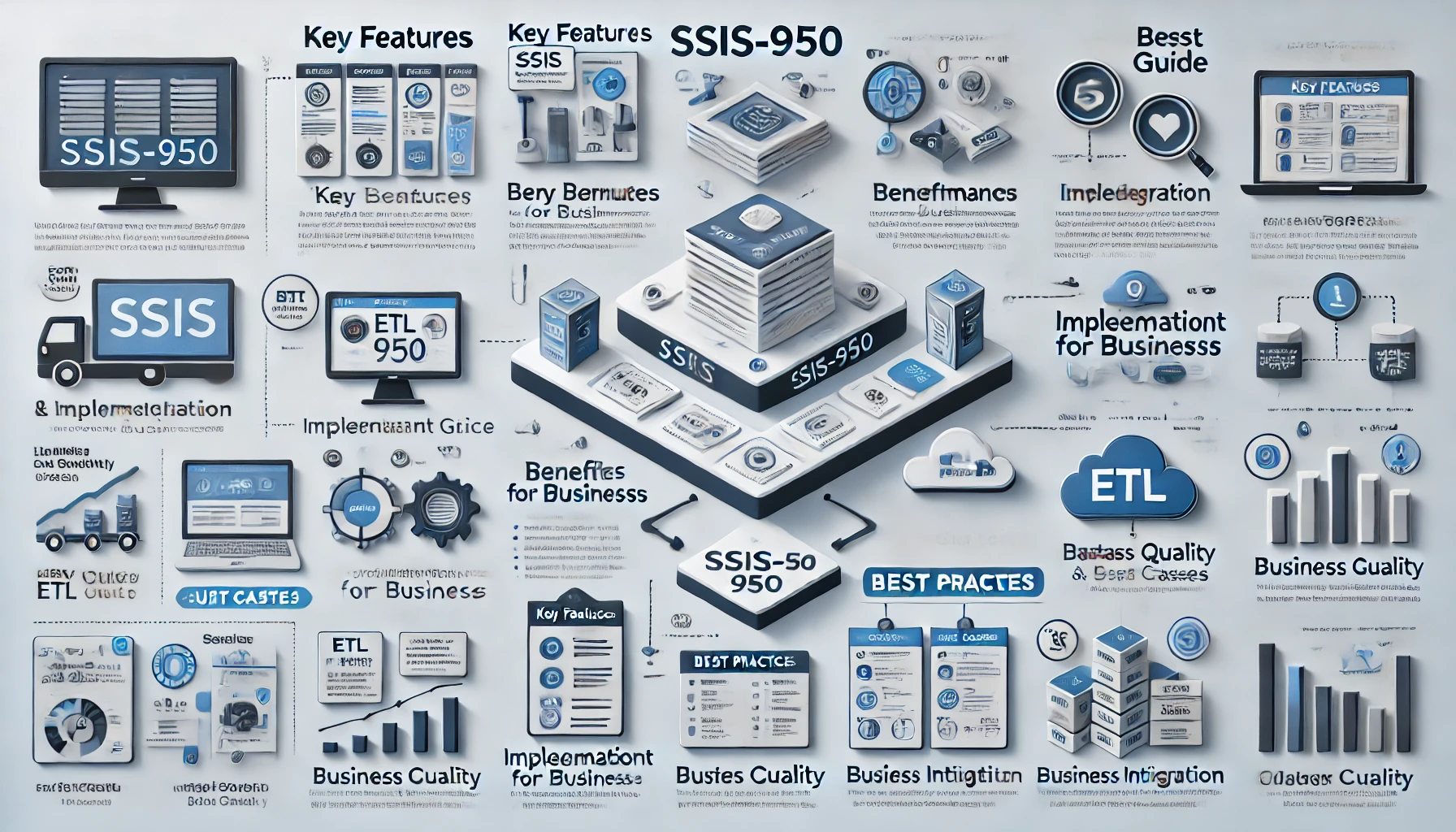
SSIS 950 stands as a powerful tool for data integration and transformation. With businesses increasingly relying on vast amounts of data, managing and processing this information efficiently is more important than ever. SSIS 950 offers enhanced features, improved performance, and robust capabilities designed to meet modern data challenges. This article will explore what makes SSIS 950 a leading choice for organizations aiming to optimize their data operations. Read on to discover the key aspects, benefits, and practical applications of SSIS 950.
What is SSIS 950?
SSIS 950, or SQL Server Integration Services 950, is a sophisticated platform for data integration, transformation, and migration. Developed by Microsoft, it is a component of the Microsoft SQL Server database software that can be used to accomplish a wide range of data migration tasks. SSIS 950 enables users to extract, transform, and load (ETL) data from various sources, allowing for seamless data flow and manipulation.
SSIS 950 is essential in the modern data landscape for several reasons. It simplifies complex data integration tasks by providing a user-friendly interface and a powerful set of tools that can handle large volumes of data efficiently. The platform supports various data sources, including databases, flat files, XML files, and cloud services, making it highly versatile.
One of the standout features of SSIS 950 is its ability to automate workflows and data processes. This automation capability significantly reduces manual intervention, thereby saving time and minimizing errors. SSIS 950 also includes advanced error handling and logging mechanisms, ensuring that any issues that arise during data processing are promptly identified and addressed.
Security is a key focus in SSIS 950. The platform provides robust security features that help protect sensitive data during integration and migration processes. It supports encryption, role-based access control, and secure connections to data sources, ensuring that data integrity and confidentiality are maintained.
SSIS 950 also offers high performance and scalability. It is designed to handle the demands of large-scale data environments, making it suitable for enterprises that process vast amounts of data daily. The performance enhancements in SSIS 950 ensure that data integration tasks are completed quickly and efficiently, even as data volumes grow.
Integration with the broader Microsoft ecosystem is another significant advantage of SSIS 950. It works seamlessly with other Microsoft products such as SQL Server, Azure, and Power BI, allowing organizations to create comprehensive data solutions that span multiple platforms. This interoperability enhances the overall functionality and value of SSIS 950.
In summary, SSIS 950 is a powerful and versatile tool for data integration and transformation. Its user-friendly interface, automation capabilities, robust security features, high performance, and seamless integration with other Microsoft products make it an ideal choice for organizations looking to optimize their data operations. Whether for data migration, data warehousing, or business intelligence, SSIS 950 provides the tools needed to manage and process data effectively.
Evolution of SSIS
The development of SQL Server Integration Services (SSIS) marks a significant journey in the field of data integration and transformation. This section explores the historical progression of SSIS, highlighting key milestones and improvements that have led to the current version, SSIS 950.

Early Beginnings with Data Transformation Services (DTS)
The story of SSIS begins with Data Transformation Services (DTS) introduced in SQL Server 7.0 in 1998. DTS provided basic ETL capabilities, allowing users to extract, transform, and load data from various sources. While innovative for its time, DTS had limited functionality and scalability, which necessitated further advancements.
SQL Server 2000: Building on DTS
SQL Server 2000 continued the use of DTS, adding more features and improving its performance. However, as data volumes and complexity grew, the limitations of DTS became apparent. This led to the conceptualization and development of a more robust and scalable solution.
Introduction of SSIS in SQL Server 2005
A significant leap occurred with the release of SQL Server 2005, where DTS was replaced by SQL Server Integration Services (SSIS). This new platform was designed from the ground up to handle complex ETL operations. SSIS 2005 introduced a graphical interface, advanced data transformation capabilities, and support for a wider range of data sources and destinations. It marked a turning point, offering substantial improvements over its predecessor.
Continued Enhancements: SQL Server 2008 and 2012
SQL Server 2008 and 2012 brought incremental enhancements to SSIS. These versions focused on performance improvements, new data transformation tasks, and better integration with other SQL Server components. For instance, SSIS 2012 introduced the project deployment model and parameters, which streamlined package management and configuration.
SSIS 2014 and 2017: Advancing Performance and Usability
With SQL Server 2014, SSIS saw further enhancements in performance and usability. This version included new data flow tasks and components, improved error handling, and enhanced deployment options. SSIS 2017 continued this trend, focusing on increasing the platform’s integration capabilities with Azure and other cloud services, as well as introducing new connectors and transformations to support modern data sources.
SSIS 950: The Latest Milestone
SSIS 950, part of SQL Server 2019, represents the latest milestone in the evolution of SSIS. It builds on the strengths of previous versions while introducing new features and improvements designed to meet contemporary data integration needs. SSIS 950 offers enhanced performance, scalability, and integration capabilities, making it a powerful tool for modern data environments.
Key enhancements in SSIS 950 include:
- Advanced Data Transformation Tools: New transformations and tasks that provide greater flexibility and control over data manipulation.
- Improved Performance and Scalability: Optimizations that allow SSIS 950 to handle larger data volumes more efficiently.
- Enhanced Security Features: Strengthened security protocols to protect sensitive data during ETL processes.
- Seamless Cloud Integration: Better support for integrating with Azure and other cloud platforms, ensuring that organizations can easily manage hybrid data environments.
The journey of SSIS from its inception as DTS to the current SSIS 950 highlights a consistent focus on innovation and adaptation to changing data landscapes. Each version has built upon the previous, addressing the growing complexity and scale of data integration tasks. Today, SSIS 950 stands as a testament to this evolution, offering a robust, scalable, and versatile solution for modern data integration needs.
Key Features and Enhancements in SSIS 950
SSIS 950 introduces a host of new features and enhancements designed to meet the demands of modern data integration and transformation tasks. This section outlines the key capabilities that make SSIS 950 a powerful tool for businesses.
Comprehensive ETL Capabilities
SSIS 950 offers robust ETL (Extract, Transform, Load) capabilities, allowing for efficient data extraction from various sources, transformation according to business rules, and loading into target systems. These processes are streamlined through an intuitive graphical interface, making it easier to design complex workflows.
Advanced Data Transformation Tools
With SSIS 950, users have access to advanced data transformation tools that provide greater flexibility in data manipulation. These tools support a wide range of transformations, including data cleansing, aggregation, and merging. This allows for more precise control over data quality and format.
High Performance and Scalability
One of the standout features of SSIS 950 is its enhanced performance and scalability. The platform is optimized to handle large volumes of data efficiently, making it suitable for enterprise-level applications. Performance improvements include faster data processing and reduced memory usage, ensuring that even the most demanding ETL tasks are executed swiftly.
Improved Data Quality and Business Intelligence
SSIS 950 emphasizes improved data quality through various built-in tools that support data validation and error handling. This ensures that only clean and accurate data is loaded into target systems. Additionally, the integration with business intelligence tools like Power BI enhances the ability to derive meaningful insights from data.
Integration with the Microsoft Ecosystem
Seamless integration with other Microsoft products is a key advantage of SSIS 950. It works effortlessly with SQL Server, Azure, and Power BI, providing a cohesive environment for data management and analytics. This interoperability allows businesses to leverage their existing Microsoft infrastructure more effectively.
User-Friendly Interface and Automation
The user interface of SSIS 950 is designed to be intuitive, reducing the learning curve for new users. It features drag-and-drop components and visual data flow diagrams, which simplify the creation and management of ETL processes. Additionally, automation features enable the scheduling of tasks, minimizing the need for manual intervention and ensuring that data integration processes run smoothly and consistently.
Enhanced Security Features
Security is a critical aspect of data management, and SSIS 950 includes robust security features to protect sensitive information. It supports encryption, role-based access control, and secure connections to data sources, ensuring that data is protected throughout the ETL process.
Seamless Cloud Integration
SSIS 950 offers enhanced support for cloud integration, making it easier to manage data in hybrid environments. It provides connectors for various cloud services, including Azure and AWS, facilitating seamless data movement between on-premises systems and the cloud. This capability is essential for businesses looking to leverage cloud infrastructure for scalability and cost efficiency.
Extensive Connectivity Options
The platform supports a wide array of data sources and destinations, including databases, flat files, XML files, and cloud services. This extensive connectivity ensures that SSIS 950 can integrate with virtually any data environment, providing flexibility and adaptability for diverse data integration scenarios.
Robust Error Handling and Logging
Error handling and logging are vital for maintaining the integrity of ETL processes. SSIS 950 includes advanced error handling capabilities that allow users to define custom error responses and logging mechanisms. This ensures that any issues are promptly identified and resolved, maintaining the reliability of data workflows.
Performance and Scalability Improvements
SSIS 950 introduces several enhancements aimed at boosting performance and scalability, making it well-suited for handling large-scale data integration tasks. These improvements are designed to ensure that data processes run smoothly and efficiently, regardless of the data volume or complexity.

Enhanced Data Processing Speed
One of the primary goals of SSIS 950 is to improve data processing speed. The platform achieves this through various optimizations, such as better resource management and more efficient execution of ETL tasks. These optimizations result in faster data extraction, transformation, and loading, reducing the time required to complete complex data workflows.
Improved Resource Utilization
SSIS 950 includes features that optimize the use of system resources, such as CPU and memory. By minimizing resource consumption during ETL operations, the platform can handle larger datasets without compromising performance. This efficient resource utilization is particularly beneficial for enterprises with significant data processing demands.
Parallel Execution and Multithreading
SSIS 950 supports parallel execution and multithreading, allowing multiple ETL processes to run simultaneously. This capability significantly enhances throughput by utilizing available system resources more effectively. As a result, large data integration tasks can be completed faster, improving overall efficiency.
Scalability for Large Datasets
The scalability of SSIS 950 ensures that it can grow with an organization’s data needs. The platform is designed to handle increasing data volumes without a loss in performance. This scalability is achieved through advanced features such as partitioning and distributed processing, which distribute the workload across multiple servers or processors.
Integration with Cloud Services
SSIS 950 offers enhanced integration with cloud services like Azure, enabling organizations to leverage the cloud for scalable data processing. Cloud integration allows for elastic scaling, where resources can be dynamically allocated based on the current data processing requirements. This flexibility ensures that organizations can handle peak data loads without investing in additional on-premises infrastructure.
Advanced Data Transformation Capabilities
The platform’s advanced data transformation capabilities also contribute to improved performance. SSIS 950 includes new and optimized transformation tasks that process data more efficiently. These tasks reduce the overhead associated with data manipulation, leading to faster ETL operations.
Efficient Data Flow Management
SSIS 950 includes improved data flow management features that optimize the movement of data through the ETL pipeline. By managing data flow more effectively, the platform reduces bottlenecks and enhances overall processing speed. This is particularly important for complex workflows that involve multiple data sources and transformations.
Load Balancing and Failover Support
To ensure continuous availability and reliability, SSIS 950 includes load balancing and failover support. These features distribute the ETL workload evenly across available resources and provide mechanisms for automatic recovery in case of failures. This ensures that data integration processes remain operational even under adverse conditions.
Improved Error Handling and Logging
Enhanced error handling and logging in SSIS 950 contribute to better performance by allowing quick identification and resolution of issues. Efficient error handling ensures that problems do not escalate, reducing the impact on overall processing speed. Detailed logging provides insights into performance bottlenecks, enabling proactive optimization of ETL processes.
Compatibility with Modern Hardware
SSIS 950 is designed to take advantage of modern hardware advancements. The platform is compatible with the latest processors and storage technologies, ensuring that it can deliver maximum performance on current and future hardware. This compatibility extends the lifespan of investments in data infrastructure.
Benefits of Using SSIS 950
SSIS 950 offers a multitude of benefits that make it a valuable tool for organizations seeking efficient data integration and transformation solutions. This section highlights the key advantages of implementing SSIS 950 in your data operations.
Increased Efficiency
SSIS 950 significantly enhances the efficiency of data integration processes. Its advanced ETL capabilities streamline the extraction, transformation, and loading of data from various sources. The automation features reduce the need for manual intervention, allowing data workflows to run seamlessly and consistently. This leads to faster completion of data tasks and frees up resources for other critical activities.
Cost Savings
Implementing SSIS 950 can lead to substantial cost savings. The platform’s ability to automate data processes minimizes the labor required for data management. Additionally, its efficient use of system resources reduces the need for extensive hardware investments. By optimizing data workflows and improving resource utilization, SSIS 950 helps organizations lower operational costs.
Improved Data Quality
Data quality is paramount for accurate analysis and decision-making. SSIS 950 includes robust data cleansing and validation tools that ensure the integrity and accuracy of data. These tools help identify and correct errors, remove duplicates, and standardize data formats, resulting in high-quality datasets that support reliable business insights.
Enhanced Business Intelligence
SSIS 950 integrates seamlessly with business intelligence tools such as Power BI, enabling organizations to derive meaningful insights from their data. The platform’s ability to handle large datasets and perform complex transformations ensures that data is readily available for analysis. This integration supports advanced reporting, analytics, and visualization, empowering decision-makers with actionable information.
Scalability and Flexibility
As organizations grow, their data needs evolve. SSIS 950 is designed to scale with these changing requirements. The platform can handle increasing data volumes and complexities, ensuring that data processes remain efficient and effective. Its flexibility allows it to adapt to various data environments, including on-premises, cloud, and hybrid setups.
Robust Security Features
Protecting sensitive data is a top priority for any organization. SSIS 950 offers robust security features to safeguard data throughout the integration process. These features include encryption, role-based access control, and secure connections to data sources. By maintaining high security standards, SSIS 950 helps organizations comply with data protection regulations and mitigate risks.
Seamless Integration with Existing Systems
SSIS 950 integrates effortlessly with existing IT infrastructure, particularly within the Microsoft ecosystem. It works in harmony with SQL Server, Azure, and other Microsoft services, providing a cohesive environment for data management. This interoperability simplifies the implementation process and enhances the overall functionality of data operations.
Automation and Error Handling
Automation in SSIS 950 reduces the complexity of managing data workflows. Scheduled tasks and automated processes ensure that data integration activities are performed consistently and accurately. Advanced error handling mechanisms promptly detect and resolve issues, minimizing disruptions and maintaining the integrity of data processes.
Enhanced Performance
The performance enhancements in SSIS 950 enable faster and more efficient data processing. Optimized execution of ETL tasks reduces the time required for data integration, allowing organizations to quickly access and utilize their data. This improved performance supports timely decision-making and enhances the overall productivity of data operations.
Comprehensive Support and Documentation
SSIS 950 is backed by extensive support and documentation from Microsoft. Users have access to a wealth of resources, including tutorials, forums, and technical support, ensuring that they can effectively utilize the platform’s capabilities. This support infrastructure helps users overcome challenges and maximize the benefits of SSIS 950.
In summary, SSIS 950 offers numerous benefits that enhance the efficiency, security, and scalability of data integration processes. Its advanced features, seamless integration with existing systems, and robust support make it a powerful tool for modern data environments. By adopting SSIS 950, organizations can achieve significant improvements in data quality, business intelligence, and overall operational efficiency.
Use Cases and Applications of SSIS 950
SSIS 950 is a versatile tool that can be applied across various industries and scenarios, enhancing data integration and processing capabilities. This section explores some of the most common and impactful use cases for SSIS 950.

Data Warehousing
Data warehousing involves the aggregation of data from multiple sources into a central repository for analysis and reporting. SSIS 950 excels in this domain by providing robust ETL capabilities that streamline the process of extracting data from various operational databases, transforming it into a consistent format, and loading it into a data warehouse. This ensures that organizations have a consolidated and accurate view of their data, facilitating better decision-making and strategic planning.
Data Migration
Data migration is the process of transferring data from one system to another. This can occur during system upgrades, cloud adoption, or mergers and acquisitions. SSIS 950 simplifies data migration by offering tools that handle the complexities of data movement. Its ability to connect to various data sources and destinations, perform necessary transformations, and ensure data integrity makes it an ideal choice for seamless and reliable data migration projects.
Business Intelligence
Business intelligence (BI) involves analyzing data to support strategic decisions. SSIS 950 plays a crucial role in BI by providing the infrastructure to gather, cleanse, and integrate data from different sources. This integrated data is then used to generate reports, dashboards, and visualizations through tools like Power BI. By delivering high-quality data for analysis, SSIS 950 helps organizations uncover insights and trends that drive business growth.
Cloud Data Integration
With the increasing adoption of cloud technologies, organizations often need to integrate on-premises data with cloud-based services. SSIS 950 offers extensive support for cloud integration, enabling seamless data flow between on-premises systems and cloud platforms such as Azure and AWS. This capability allows organizations to leverage the scalability and flexibility of the cloud while maintaining control over their data.
Real-time Data Processing
Real-time data processing is essential for applications that require immediate insights and actions, such as fraud detection, customer interactions, and supply chain management. SSIS 950 supports real-time data integration by providing tools that handle streaming data and enable real-time transformations. This ensures that organizations can respond promptly to changing conditions and make informed decisions based on up-to-date information.
Data Cleaning
Data cleaning is the process of identifying and correcting errors and inconsistencies in datasets. SSIS 950 includes advanced data transformation tools that automate data cleaning tasks, such as deduplication, validation, and standardization. By ensuring that data is accurate and consistent, SSIS 950 helps improve the quality of analytics and reporting, leading to more reliable business insights.
Data Integration for Compliance
Regulatory compliance often requires organizations to integrate and report on data from various sources. SSIS 950 facilitates compliance by providing robust data integration and transformation capabilities. It ensures that data is collected, processed, and reported in accordance with regulatory requirements, helping organizations avoid penalties and maintain their reputation.
E-commerce
In the e-commerce sector, data integration is vital for managing inventory, processing transactions, and analyzing customer behavior. SSIS 950 helps e-commerce businesses integrate data from different systems, such as online storefronts, payment gateways, and customer relationship management (CRM) platforms. This integrated data supports better inventory management, personalized marketing, and enhanced customer experiences.
Healthcare Sector
Healthcare organizations generate vast amounts of data from electronic health records (EHRs), patient management systems, and medical devices. SSIS 950 assists in integrating and processing this data to improve patient care, streamline operations, and comply with healthcare regulations. Its ability to handle diverse data formats and ensure data integrity makes it a valuable tool for the healthcare industry.
Financial Services
In the financial sector, accurate and timely data is crucial for risk management, fraud detection, and regulatory compliance. SSIS 950 supports financial institutions by providing robust data integration and transformation capabilities. It enables the aggregation and analysis of data from various sources, such as transaction systems, market data feeds, and customer databases, ensuring that financial organizations can make informed decisions and maintain regulatory compliance.
Conclusion
SSIS 950 stands out as a powerful tool for data integration and transformation, offering advanced features and enhancements that cater to modern data needs. Its robust ETL capabilities, enhanced performance, and seamless integration with the Microsoft ecosystem make it an invaluable asset for organizations. By improving efficiency, ensuring high data quality, and providing extensive support for various applications, SSIS 950 empowers businesses to handle their data challenges effectively. Whether in data warehousing, migration, business intelligence, or real-time processing, SSIS 950 delivers the tools necessary for achieving reliable and efficient data operations. Adopting SSIS 950 can lead to significant improvements in data management and overall business productivity.
FAQs
1. What is SSIS 950 and how does it differ from previous versions?
SSIS 950 is the latest version of SQL Server Integration Services, offering enhanced performance, advanced data transformation tools, and improved scalability. Compared to previous versions, SSIS 950 provides better integration with cloud services, more efficient resource utilization, and enhanced security features.
2. Can SSIS 950 handle large volumes of data efficiently?
Yes, SSIS 950 is designed to handle large datasets with improved processing speed and optimized resource management. Its parallel execution and multithreading capabilities ensure efficient data handling, making it suitable for enterprise-level applications.
3. How does SSIS 950 support cloud integration?
SSIS 950 offers extensive support for cloud integration, enabling seamless data flow between on-premises systems and cloud platforms like Azure and AWS. It includes connectors for various cloud services, allowing organizations to manage hybrid data environments effectively.
4. What security features are available in SSIS 950?
SSIS 950 includes robust security features such as encryption, role-based access control, and secure connections to data sources. These features help protect sensitive data throughout the ETL process, ensuring compliance with data protection regulations.
5. How can SSIS 950 improve business intelligence efforts?
SSIS 950 integrates seamlessly with business intelligence tools like Power BI, enabling the efficient gathering, cleansing, and integration of data from various sources. This supports advanced reporting, analytics, and visualization, helping organizations derive meaningful insights and make informed decisions.









